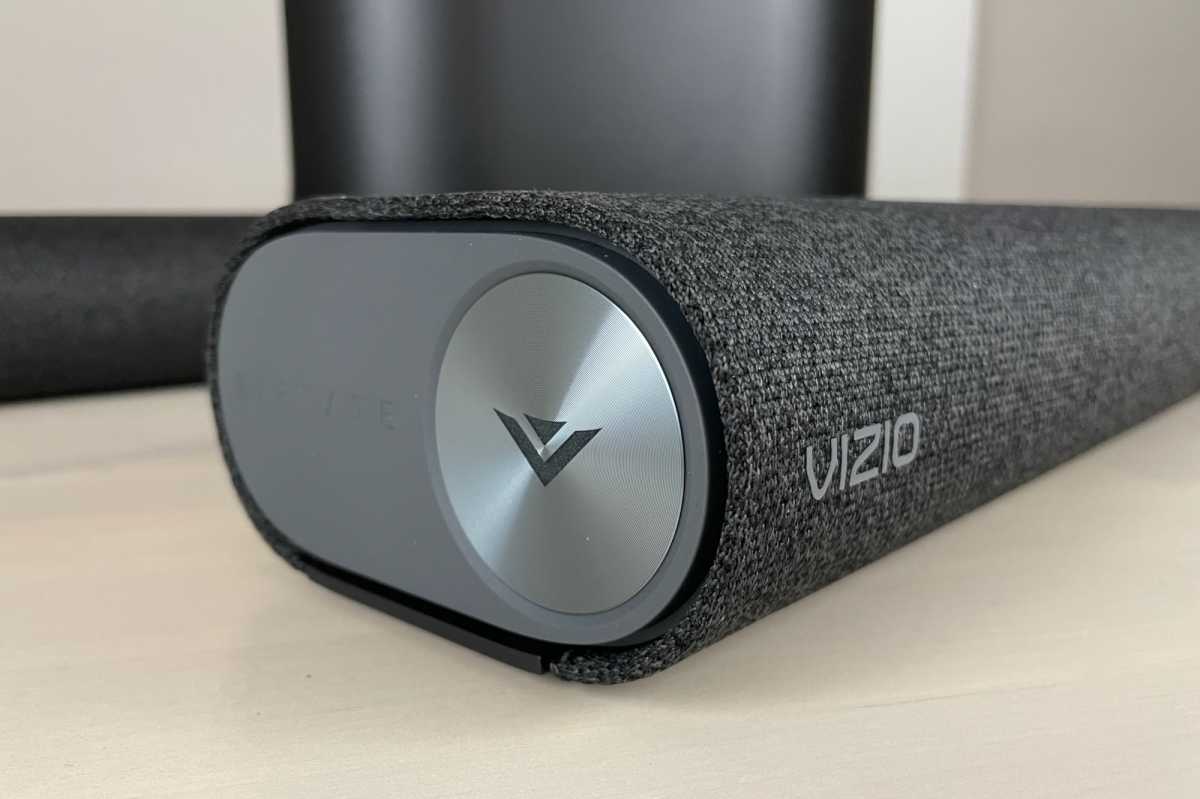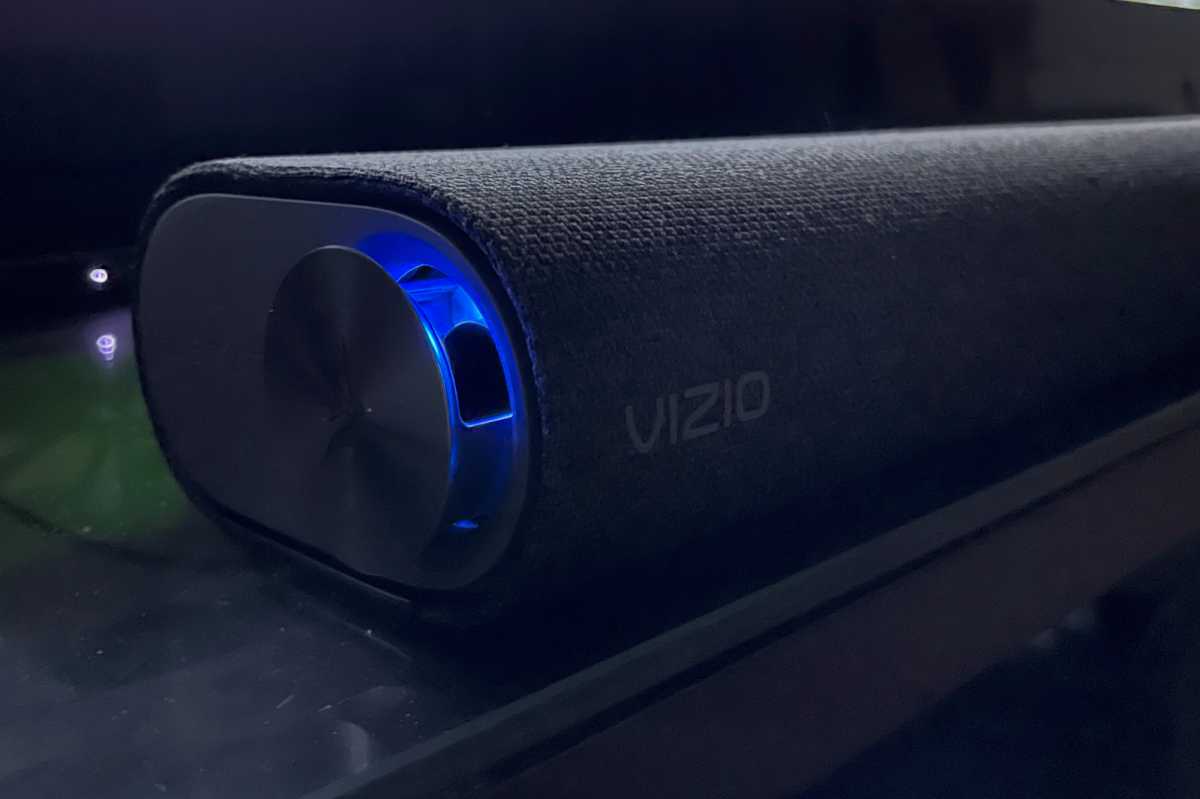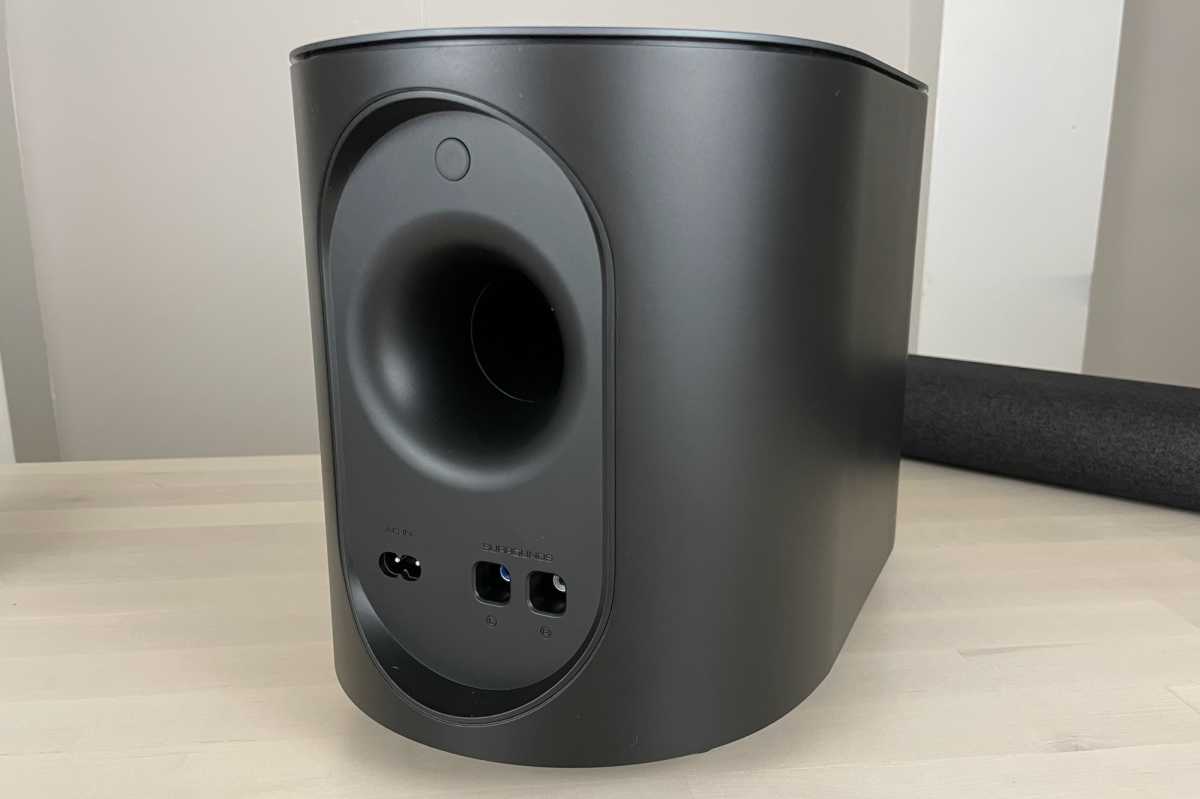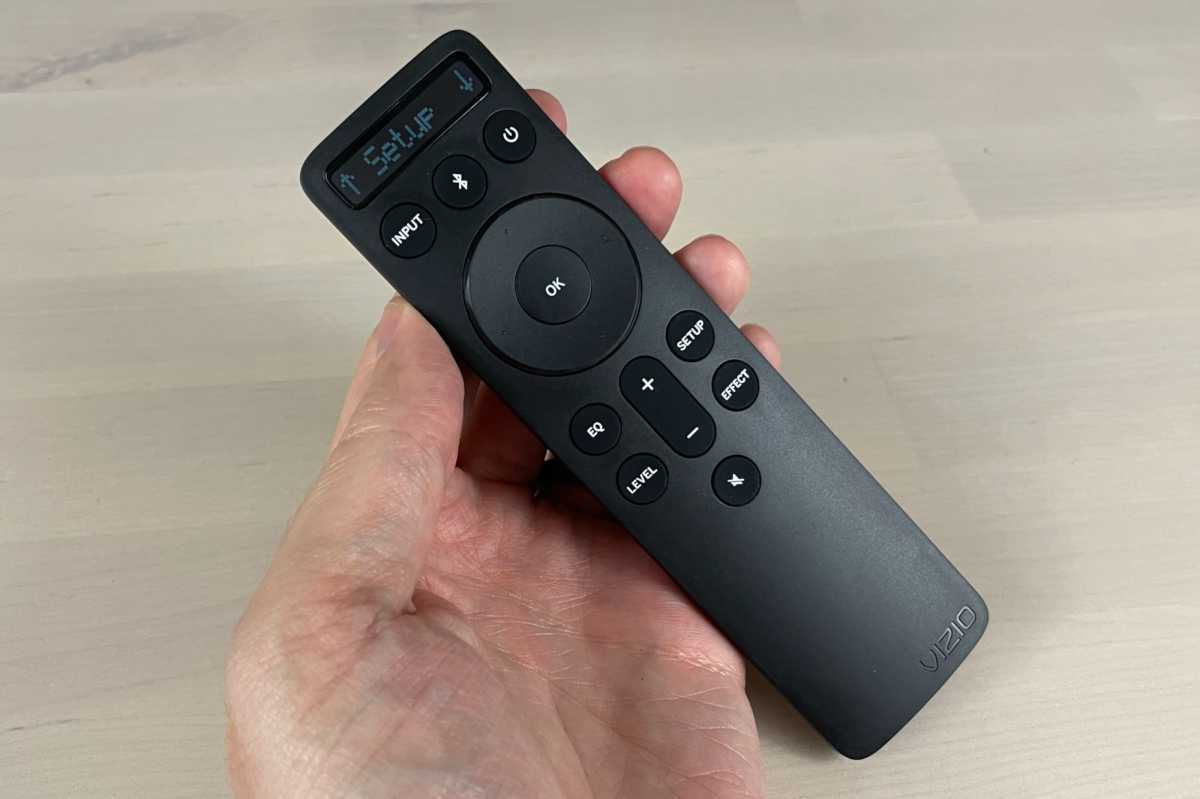At a glance
Expert’s Rating
Pros
- Crisp, robust sound
- Rotating drivers that swivel up for Dolby Atmos effects
- Nifty LED-accented speaker ports peek out from the sides
- Dedicated 3.5mm jack for a smart speaker
Cons
- No Wi-Fi connectivity
- Height effects are on the subtle side
- The step-up P-Series Elevate doesn’t cost much more
Our Verdict
The M-Series Elevate boasts rotating drivers, snazzy LED-accent speaker ports, and rich, detailed sound, but it’s pricey for a non-Wi-Fi soundbar, and the step-up P-Series costs only a couple hundred more.
Price When Reviewed
Vizio M-Series Elevate (M512E-K6): $799.99
Best Prices Today: Vizio M-Series Elevate (M512E-K6)
Not Available
Vizio has followed up its groundbreaking P-Series Elevate soundbar with a mid-range model that shares its predecessor’s signature feature: rotating drivers that swivel up for Dolby Atmos height effects. The M-Series Elevate riffs on the P-Series’s unique design, going for a unibody fabric-wrapped chassis with eye-catching, LED-accented port tubes that slide out whenever the rotating drivers point toward the ceiling.
The 5.1.2-channel M-Series Elevate marks one of the snazziest-looking soundbars I’ve ever tested, and those glowing speaker ports add a bit of drama when an Atmos-enabled movie starts to stream. But this mid-range Elevate drops some key features of its pricier sibling, namely Wi-Fi and built-in Chromecast, and at $799, it’s only $200 less than the retail price of the (frequently discounted) P-Series Elevate. The top-of-the-line Elevate also benefits from two additional height channels, which means more Atmos effects coming from above.
Meanwhile, there’s also Vizio’s other M-Series 5.1.2-channel soundbar, the M512A-H6, which is our reigning mid-range soundbar pick. The M512A-H6 lacks the M-Series Elevate’s rotating drivers, but it still packs excellent Atmos audio for the price–just $499, a bargain compared to the new Elevate.
So, is the M-Series Elevate worth it given the premium price tag? Let’s discuss.
This review is part of TechHive’s in-depth coverage of the best soundbars.
Does the M-Series Elevate look different from the P-Series Elevate?
The P-Series and M-Series Elevate may share the whole “Adaptive Height Channel” concept (more on that in a moment), but the soundbars themselves look quite different.
While the P-Series Elevate has a perforated chassis with end caps that clearly rotated as the height drivers swiveled into position, the M-Series has a unified, fabric-covered design that keeps the rotating drivers hidden.

Here’s what the M-Series Elevate’s side speaker port looks like when closed…
Ben Patterson/Foundry
Also setting the M-Series Elevate apart are the cylindrical speaker ports that peek out from the left and right sides of the soundbar when the height drivers are engaged.
Highlighting the speaker ports are LED accent lights that can glow in one of nine different colors, delivering a dramatic bit of flair when the soundbar detects Dolby Atmos or DTS:X audio. It’s a cool effect, but it can also be distracting; luckily, you can change the accent color to something less flashy (I thought blue was the most subtle) or simply turn off the LEDs altogether.

…and here’s how it looks open, with the LED accent light set to blue (you can turn it off, too).
Ben Patterson/Foundry
How many drivers does the Vizio M-Series Elevate have?
The Vizio M-Series Elevate uses a total of 13 drivers to power its 5.1.2 channels of audio, including left, center, and right channels, left and right surround channels, low-frequency effects (delivered by the wireless subwoofer), and the left and right height channels. Each channel in the main soundbar unit gets its own mid-range driver and tweeter, while the two satellite speakers each get a single driver and a bass reflex port.
Those two height channels are what Vizio calls “Adaptive Height Channels,” which (like on the older, pricier P-Series Elevate) can rotate up to bounce Dolby Atmos and DTS:X height cues off your ceiling, or swivel forward to bolster the left and right channels for standard 5.1 or stereo content.
The rationale behind Vizio’s rotating drivers is that they allow the Elevate to make the most of its 13 drivers no matter what type of audio content is currently playing. It’s a clever idea that worked well for the P-Series Elevate, and we’ll discuss how they fare with the M-Series version later in the review.
How many HDMI ports does the Vizio M-Series Elevate have?
The Vizio M-Series Elevate has two HDMI ports–a single HDMI input and one HDMI output that doubles as an HDMI-eARC interface.
With the M-Series Elevate’s HDMI input, you can connect a video source (such as a streaming video player, game console, or Blu-ray player) then send both video (4K HDR passthrough is supported) and audio to your TV via the HDMI output. It’s a fairly straightforward setup, but the single HDMI input restricts you to just one video source. (The P-Series Elevate has two HDMI inputs rather than just one).
Another, much easier option is to use the Elevate’s HDMI-eARC functionality. Thanks to HDMI-eARC, your TV will be able to deliver audio from its built-in smart TV apps as well as any video sources connected to its HDMI inputs down to the soundbar, including lossless Dolby TrueHD and DTS-HD Master Audio tracks on Blu-ray discs. Besides being simple, such an HDMI-eARC setup means you can hook up as many video sources as your TV has HDMI inputs.

The Vizio M-Series Elevate has one HDMI input and an HDMI output that double as an HDMI-eARC interface.
Ben Patterson/Foundry
The M-Series Elevate also supports inputs for older TVs that lack HDMI, including optical (Toslink) and a 3.5mm analog auxiliary jack. An optical cable is included with the Elevate (along with the aforementioned HDMI cable), but you’ll need to supply your own 3.5mm-to-RCA Y-cable to take advantage of the AUX port.
What other inputs does the M-Series Elevate have?
Besides the HDMI, optical, and 3.5mm auxiliary inputs, the Vizio M-Series Elevate has a second AUX input for a smart speaker.
Just plug in (say) an Amazon Echo Dot, and the Elevate will pipe the Dot’s audio through its own drivers, even lowering its own audio when you summon Alexa or Google Assistant. And speaking of Google Assistant, the Elevate can also connect to a smart speaker via Bluetooth, handy for a device like the Google Nest Mini that lacks a wired AUX output. So far, Vizio is the only soundbar manufacturer to offer a dedicated smart speaker input, and I’m surprised no one else has copied them.
Finally, the M-Series Elevate has a USB-A input, but it only supports WAV and MP3 files, not FLAC containers.
Does the M-Series Elevate support Bluetooth and Wi-Fi?
As I mentioned a moment ago, the M-Series Elevate can connect to a smart speaker via Bluetooth (version 5.0), and you can stream audio to the soundbar over Bluetooth as well. You can pair a Bluetooth audio device to the Elevate using the Bluetooth button on top of the main soundbar unit, or using the Bluetooth button on the remote.
Unfortunately, the M-Series Elevate doesn’t support Wi-Fi, which means there’s no Wi-Fi audio casting via Apple’s AirPlay 2, Google Chromecast, or Spotify Connect, nor is there any native streaming service support. That’s a surprising–and somewhat glaring–omission for a soundbar in this price range. It’s worth noting that the $999 P-Series Elevate, which has an MSRP that’s only $200 more than the M-Series Elevate, does boast Wi-Fi connectivity, including built-in Chromecast.
Of course, you can still play music on the M-Series Elevate by streaming tunes over Bluetooth, playing music streamed from your TV, or by teeing up playlists on a connected smart speaker.
How do you set up the Vizio M-Series Elevate?
Measuring 41.4 x 2.6 x 4.7 inches (WxHxD) and weighing in at 8.73 pounds, the M-Series Elevate stretches almost the entire length of a 55-inch TV. Since it’s less than three inches tall, however, the soundbar probably won’t block the bottom of your TV screen; in the case of my low-sling LG C9 OLED, the M-Series Elevate only blocked a sliver of the TV’s bottom edge when placed directly in front.
Of course, another option besides putting the M-Series Elevate in front of the TV is to mount it beneath your set. If you’re up to the challenge, the Elevate comes with a mounting kit that includes brackets, screws, and a mounting template.
Vizio has redesigned its typical boxy subwoofer for the M-Series Elevate, which now has a smaller (7.9 x 9.6 x 13.8 inches, WxHxD), more rounded form factor. The even more compact satellite speakers (6.3 x 2.6 x 4.7 inches, WxHxD) plug into the subwoofer, and a pair of generously long (roughly 30-foot) cables offer plenty of latitude in terms of speaker placement.

The M-Series Elevate’s subwoofer has an appealingly rounded design.
Ben Patterson/Foundry
Once you power up the main soundbar unit and pre-paired subwoofer, the two speakers should automatically make a wireless connection (or at least, they did for me); the components can also be paired manually.
Does the Vizio M-Series Elevate come with a remote?
Vizio is one of the few (and perhaps only) major soundbar manufactures to ship a soundbar remote with a backlit display, allowing you to dip into the M-Series Elevate’s various menus and submenus in the dark.
An EQ button lets you cycle through the Elevate’s sound modes (Movie, Music, Game, and so on), while the Level button allows you to trim speaker levels (you can’t adjust the volume of individual speakers, but you can tweak the levels for bass, treble, dialogue, center, surround, surround balance, and height).
There’s also a circular navigation pad, input, Bluetooth, and power buttons at the top, and a mute button at the bottom in its own row.

Vizio’s soundbar remote is one of the few to ship with a backlit display.
Ben Patterson/Foundry
Besides using the remote, you can also control the M-Series Elevate with on-screen menus if you have a newer model Vizio TV. Those on-screen menus will let you switch sound modes, adjust speaker levels, perform speaker tests, and more.
What sound modes does the Vizio M-Series Elevate have?
As with Vizio’s other recent soundbars, the M-Series Elevate has Movie, Music, Direct, and Game modes, while a Night mode compresses the Elevate’s dynamic range for late-night listening sessions. There’s no dialogue-boosting Voice mode, but you can always dial up the Dialogue volume in the Elevate’s Level settings.
The soundbar also offers DTS Virtual:X, a virtualized 3D audio mode that could come in handy if your ceiling is too high, too short, vaulted or otherwise ill-suited for upfiring drivers.
The M-Series Elevate has three modes for its rotating drivers: “Up,” which keeps the drivers swiveled up at all times (and upmixes all audio to 5.1.2 in the process); “Wide,” which keeps the drivers in front-firing position; and “Auto,” which automatically swivels the drivers up whenever the soundbar detects Dolby Atmos or DTS:X audio.
How does the Vizio M-Series Elevate sound?
Overall, I was pretty happy with the M-Series Elevate’s audio performance. The soundbar plays it right down the middle, serving up crisp, robust, and accessible sound.
OK, but did the M-Series Elevate “wow” me with its audio? Well, not exactly. That’s not to say there’s anything wrong with the sound–maybe “familiar” is a better word, particularly having tested several other Dolby Atmos-enabled Vizio soundbars. The pricier, two-year-old P-Series Elevate gets the edge in terms of pure excitement, thanks in part to its beefier subwoofer and two extra height channels.
To be fair, the M-Series Elevate is no slouch, and its punchy low-frequency response gives it a slight (very slight) lead over the older, but much less expensive 5.1.2-channel M-Series M512a-H6.
As usual, I started my listening tests with the UHD Blu-ray of Star Wars: The Empire Strikes Back, and as the Rebel snowspeeders whizzed around the hulking Imperial Walkers, I was impressed by the rich, detailed, and warm sound, a hallmark of Vizio’s overall soundbar range. John Williams’s operatic score sounded crisp but never harsh, while the showering debris from a toppled Walker peppered the snow with satisfying “plops.”
The M-Series Elevate’s subwoofer churned tight bass that didn’t seep into boomy territory as does the P-Series Elevate’s sub; then again, the reason the P-Series subwoofer is boomier is because it’s bigger and can produce tones as low as 30Hz, versus 45Hz for the M-Series (lower frequencies are deeper).
Atmos performance on the M-Series Elevate was, well, fine. I could hear height cues when an Imperial Walker’s foot nearly crushed Luke Skywalker, as well as when clumps of snow fell from the crushed ceiling of the Rebel’s hidden base. But the height effects were quite subtle, adding more of a sense of airiness than of precise sound cues from above. Of course, you can always dig into the Elevate’s level settings to boost those height effects, but if you’re looking for in-your-face Atmos, you might be happier with the P-Series Elevate, or another soundbar with four (or more) height channels.
I also tried the UHD Blu-ray of Apollo 13, which has DTS:X sound, and (once again) I was pleased by the smooth, rich sound as the Saturn V rocket rose from the launch pad. James Horner’s rousing score swelled without getting brassy, the rumble of the spacecraft’s engines felt deep but not boomy, and dialogue was crisp and clear but not harsh. There were also some subdued DTS:X height cues as the Saturn V soared skyward.
For some non-Atmos content, I spun up the standard Blu-ray of Wong Kar-wai’s The Grandmaster, trying the 5.1-channel DTS-HD Master Audio track with the M-Series Elevate’s swiveling drivers in both the “up” and “wide” positions. With the drivers pointing toward the ceiling, the upmixed audio emphasized the cascading raindrops in the opening sequence, as Tony Leung’s Ip Man battled dozens of attackers. With the drivers facing forward, the soundstage was a tad wider, but the raindrops no longer sounded (or at least, not as much) like they were falling from above.
Switching to music, I dialed up “The Ghost of Tom Joad” by Bruce Springsteen from Apple Music (played though my connected Apple TV), and the track sounded superb–warm, clear, and alive, although the bass response was a tad boomy (adjusting the bass levels helped, and a subwoofer crawl would probably solve any ongoing issues). Billie Eilish’s “Oxytocin” was a hoot in Dolby Atmos, with her breathy vocals shimmying in the Elevate’s surrounds and the deep bassline giving the soundbar woofers a serious workout. In another Atmos mix, Bertrand Chamayou’s performance of Maurice Ravel’s solo piano works for Erato sounded precise and atmospheric, without devolving into mushiness.
Is the Vizio M-Series Elevate worth the cash?
When Vizio initially announced the M-Series Elevate back in January 2022, it floated a $699 price tag–still pricey for a soundbar without Wi-Fi, but still roughly in mid-range territory. At $799, however, the M-Series Elevate feels pricey for what you get, rotating drivers or no.
So while I don’t think you’d go wrong with the M-Series Elevate from a performance standpoint, there are better values out there. The P-Series Elevate lacks the M-Series’s cool, LED-accented speaker ports, but it has two more upfiring drivers, Wi-Fi, and Chromecast, all for just $200 more–and given that it’s frequently on sale, you can snag it for $699 or less if you’re patient.
And if you’re willing to forgo the rotating drivers, the older 5.1.2-channel M512a-H6 cranks out excellent Atmos performance for $300 less than the M-Series Elevate (and like the P-Series Elevate, the M512a-H6 is frequently discounted, sometimes by $100 or more). I did think that the M512a-H6’s subwoofer (which is roughly equivalent to the M-Series Elevate’s sub in terms of performance) was a tad boomy for my taste, but that could be fixed with level adjustments and careful placement.

